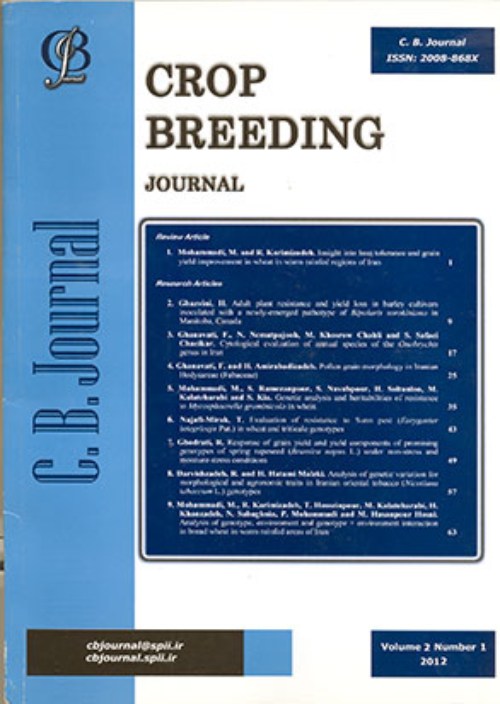Dissection of genotype × environment interaction and assessment of adaptability and grain yield stability of spring bread wheat genotypes
Author(s):
Article Type:
Research/Original Article (دارای رتبه معتبر)
Abstract:
Additive main effects and multiplicative interactions (AMMI) and genotype (G) main effect plus genotype × environment interaction (GEI) GGE biplot models were used to dissect GEI interaction and to assess adaptability of 26 elite bread wheat lines. A multi environment trial was conducted using 26 elite bread wheat lines along with two check cultivars of Chamran and Chamran-2 in 2014-15 and 2015-16 cropping seasons across six testing sites including; Darab (DAR), Dezful (DEZ), Ahvaz (AHV), Khorramabad (KHR), Zabol (ZAB) and Iranshahr (ISH). The sites are representative of the major irrigated wheat production agro-ecologies in southern warm and dry zone of Iran. In each year, the trials at DAR, DEZ and KHR were grown under normally irrigated conditions while trials at AHV, ZAB and ISH were grown under terminal drought stress conditions. Mixed model analysis using Restricted Maximum Likelihood (REML) method showed significant differences among spring bread wheat genotypes for grain yield in all environments. The highest and lowest BLUE means was observed at KHR15 and ZAB15, respectively. Compared to irrigated environments, genotypes showed 35.4% losses, in average, of grain yield under terminal drought stress environments. Combined analysis of variance showed that genotype × environment interaction (GEI) accounted for 9.4% of the total sum of squares. Significant GEI suggests variability in performance of bread wheat genotypes across environments. Partitioning of GEI through AMMI analysis showed that axes IPCA1, IPCA2, and IPCA3 were highly significant (P>0.01) and explained 33%, 22%, and 13% of the GE sum of squares, respectively. The polygon view of the GGE biplot grouped environments into three sectors. AMMI method and GGE biplot showed that G5 had the highest grain yield stability. G5 and G15 were generally better adapted to terminal drought stress environments (AHV14, AHV15, ISH14, ISH15, ZAB14 and ZAB15), while G28 and G8 were more adapted to irrigated environment conditions. AMMI and GGE biplot methods separated the western and southwest regions from the south and southeast test locations for identifying superior adapted spring bread wheat genotypes. Results showed that geographical location had greater impact than the effect of moisture management on the grouping of genotypes. The specific adaptation strategy is suggested for identifying adapted spring bread wheat cultivars with high grain yield and yield stability for these target environments.
Keywords:
Language:
English
Published:
Crop Breeding Journal, Volume:11 Issue: 2, Winter-Spring 2021
Pages:
11 to 24
magiran.com/p2514776
دانلود و مطالعه متن این مقاله با یکی از روشهای زیر امکان پذیر است:
اشتراک شخصی
با عضویت و پرداخت آنلاین حق اشتراک یکساله به مبلغ 1,390,000ريال میتوانید 70 عنوان مطلب دانلود کنید!
اشتراک سازمانی
به کتابخانه دانشگاه یا محل کار خود پیشنهاد کنید تا اشتراک سازمانی این پایگاه را برای دسترسی نامحدود همه کاربران به متن مطالب تهیه نمایند!
توجه!
- حق عضویت دریافتی صرف حمایت از نشریات عضو و نگهداری، تکمیل و توسعه مگیران میشود.
- پرداخت حق اشتراک و دانلود مقالات اجازه بازنشر آن در سایر رسانههای چاپی و دیجیتال را به کاربر نمیدهد.
In order to view content subscription is required
Personal subscription
Subscribe magiran.com for 70 € euros via PayPal and download 70 articles during a year.
Organization subscription
Please contact us to subscribe your university or library for unlimited access!



